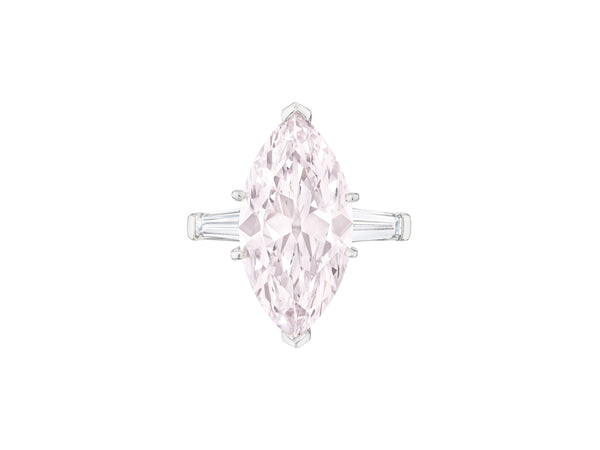What are 5-Carat Diamonds?

Welcome to our in-depth exploration of what 5-carat diamonds are, how to shop for 5-carat diamonds and how to design with 5-carat diamonds in bespoke high jewellery. Selecting the ideal diamond for your bespoke jewellery design is a momentous decision, and grasping the intricacies of carat weight is essential for making a well-informed choice. In this blog post, we will uncover the mysteries surrounding 5 carat diamonds, from their characteristics to their significance in the world of luxury.
Understanding Carat Weight
A carat is a unit of measurement used to quantify the weight of a diamond. One carat is equivalent to 200 milligrams, or 0.2 grams. The term "carat" originated from the carob seeds historically used as counterweights on balance scales due to their relatively uniform weight.
Carat weight is one of the "Four Cs" used to evaluate the quality and value of diamonds, along with cut, colour, and clarity. While carat weight primarily determines the size of a diamond, it's important to note that two diamonds of equal carat weight can vary significantly in terms of overall value and appearance depending on other factors. Additionally, as carat weight increases, the rarity and price of diamonds tend to increase exponentially, especially at higher weights such as 5 carats.

While carat weight is often associated with a diamond's size, it's not the sole determinant. Different diamonds can have the same carat weight but vary in dimensions due to variations in their cut, shape, and proportions. How a diamond is cut can significantly impact its visual size and overall appearance. A bespoke jewellery designer will guide you through the key considerations of 5ct diamond size.
Spread: Spread refers to how a diamond's weight is distributed across its physical size. Diamonds with ideal cut proportions can appear larger (have a greater spread) for their carat weight, as they reflect more light and maximise their visual appeal. On the other hand, diamonds with poorer cut quality may have a smaller spread, appearing smaller for their carat weight.
Face-up Appearance: The face-up appearance of a diamond refers to how it looks when viewed from the top. Two diamonds with the same carat weight but different dimensions can have noticeable differences in their face-up appearance. Factors such as table size, crown height, and pavilion depth can affect how the diamond appears to the naked eye.

Carat weight impacts the value of a diamond on a non-linear scale. Large-sized diamonds are so rare that the value of diamonds does not increase in proportion to their weight. This means that a two-carat diamond will cost more than double that of a one-carat diamond. The reason for this non-linear pricing is multifaceted:
Larger diamonds are harder to find, mine, and cut without flaws, contributing to their scarcity and driving up their value.
The demand for larger diamonds, particularly those over five carats, is relatively low compared to smaller stones, further increasing their rarity.
The brilliance and fire of a diamond are influenced by its cut, and cutting a larger stone to ideal proportions without sacrificing quality requires exceptional skill and expertise, adding to the overall cost.
As a result, the price per carat typically increases with diamond size, but not linearly, making the value assessment more complex for consumers in the market for larger diamonds.
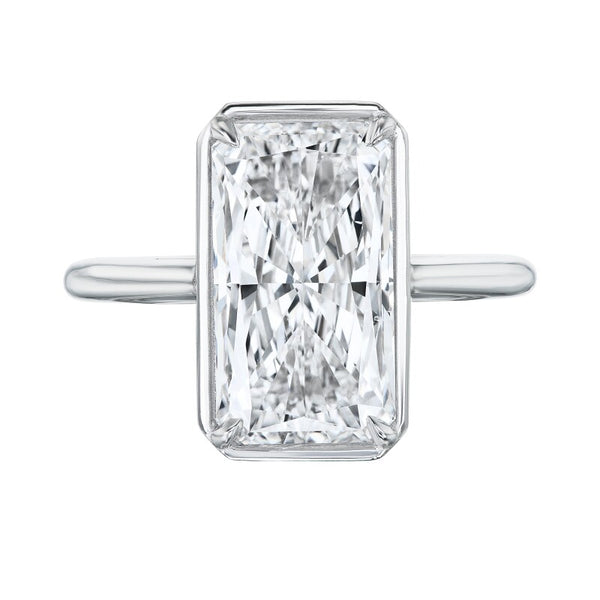
Characteristics of 5 Carat Diamonds
When designing a bespoke fine jewellery piece with 5-carat diamonds, it's essential to understand that these diamonds possess unique attributes that distinguish them from diamonds of other sizes. Here's an expanded overview of the characteristics specific to 5-carat diamonds:
Size and Presence
5-carat diamonds are substantial in size, making them highly noticeable and impactful. They command attention and create a striking presence when worn as bespoke high jewellery pieces, such as engagement rings or pendants. The size of a 5-carat diamond also allows for intricate detailing and craftsmanship in its setting. With a bespoke jewellery designer, this means there is a lot of room for creative design elements.
Clarity and Transparency
Despite their size, 5-carat diamonds can exhibit remarkable clarity and transparency. With proper grading and selection, these diamonds can showcase minimal to no internal flaws (inclusions) or external blemishes, enhancing their brilliance and sparkle. High clarity grades, such as Internally Flawless (IF) or Very, Very Slightly Included (VVS), are particularly prized in 5-carat diamonds.
Colour
The colour of a 5-carat diamond can vary, ranging from colourless to near-colourless to faintly coloured. Colour grading, as per the GIA (Gemological Institute of America) scale, determines the presence of any tint within the diamond. Colourless diamonds (graded D to F) are highly sought after for their purity and brilliance, while near-colourless (graded G to J) diamonds offer exceptional value with minimal perceptible colour.
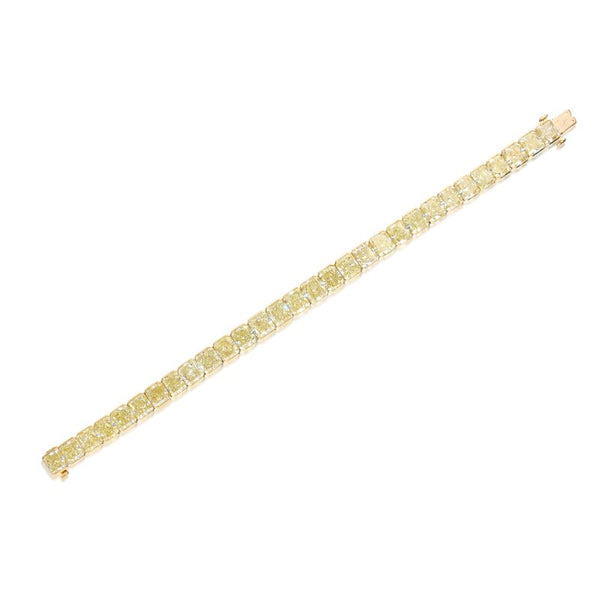
Cut Quality
The cut of a 5-carat diamond plays a significant role in maximising its beauty and brilliance. A well-cut diamond exhibits excellent proportions, symmetry, and polish, allowing light to reflect and refract optimally within the stone. The right cut enhances the diamond's fire, scintillation, and overall visual appeal, making it sparkle intensely.
Shape Options
5-carat diamonds are available in various shapes, each offering its own unique aesthetic appeal. Popular shapes include round brilliant, radiant, emerald, cushion, and oval, among other more rare diamond cuts. High end bespoke jewellery designer, Layla Kaisi is able to source the most rare, exclusive diamond cuts like kite, shield, half-moon etc. making your 5ct diamond even more one-of-a-kind. The choice of shape often depends on personal preference and style, with each shape highlighting different aspects of the diamond's brilliance and character.
Certification
Given the significant value and investment associated with 5-carat diamonds, it's crucial to ensure their authenticity and quality through reputable diamond certification. Certifying bodies such as the GIA or AGS (American Gem Society) provide detailed assessments of a diamond's characteristics, including carat weight, cut, colour, and clarity, offering buyers confidence and peace of mind.

Image Source: Sothebys | White Gold and 12.49ct Diamond Convertible Earrings
Rarity and Value
The rarity and value of 5-carat diamonds are influenced by several market dynamics and pricing factors, making them highly coveted and valuable in the world of luxury jewellery.
One of the primary factors contributing to the value of 5-carat diamonds is their scarcity. Diamonds of this size are relatively rare compared to smaller carat weights, as they represent a smaller percentage of total diamond production. The natural formation process of diamonds, coupled with the stringent criteria for quality and size, further limits the availability of 5-carat diamonds in the market.
The demand for 5-carat diamonds is driven by their desirability among affluent consumers, collectors, and connoisseurs of high jewellery design. These diamonds symbolise luxury, sophistication, and exclusivity, appealing to individuals seeking to make a statement with their bespoke jewellery design. The value of 5-carat diamonds is also influenced by their quality and rarity grading, encompassing factors such as colour, clarity, cut, and carat weight. Diamonds with exceptional characteristics, such as colourless clarity, high colour grades, and superior cut craftsmanship, command premium prices in the market. Additionally, diamonds that exhibit rare qualities, such as fancy coloured diamonds can further enhance their value and desirability.
Market trends and economic conditions play a significant role in determining the pricing dynamics of 5-carat diamonds. Fluctuations in global economic indicators, such as consumer confidence, disposable income levels, and investment preferences, can impact the demand and pricing of luxury goods, including diamonds. Additionally, geopolitical factors, currency exchange rates, and supply chain disruptions can influence the overall stability and pricing volatility of the diamond market. The authenticity and quality certification of 5-carat diamonds by reputable gemological laboratories, such as the Gemological Institute of America (GIA) are instrumental in establishing their market value and credibility. Certified diamonds undergo rigorous evaluation and grading processes, providing buyers with assurance regarding their authenticity, provenance, and intrinsic worth.
The rarity and value of 5-carat diamonds are shaped by a complex interplay of market forces, consumer preferences, and quality considerations.
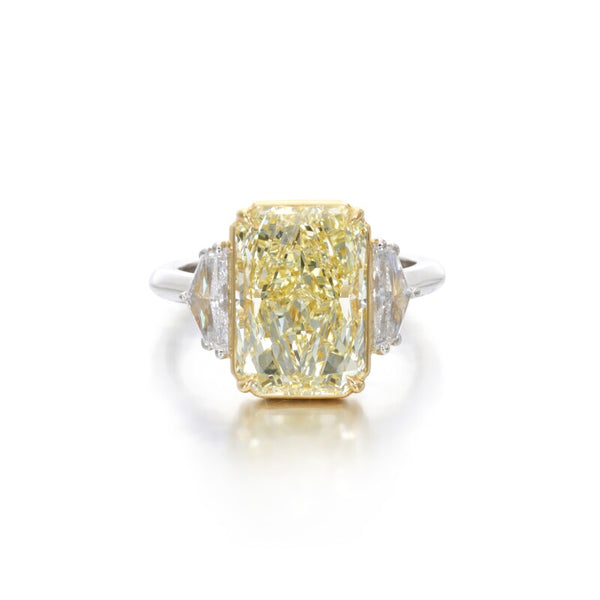
Image Source: Sothebys | Platinum, Gold, 5.02ct Fancy Yellow Diamond and Diamond Engagement Ring
Popular Settings and Styles
Settings and bespoke jewellery designs styles that compliment 5-carat diamonds:
- Toi et Moi: The Toi et Moi setting features two gemstones placed side by side, symbolising the unity of two souls. It represents the intertwining of two individuals in a harmonious and everlasting bond, making it a romantic choice for engagement rings or anniversary gifts.
- Halo: The Halo setting surrounds the centre diamond with a circle or halo of smaller diamonds or gemstones, enhancing its brilliance and creating a striking visual impact. This setting adds sparkle and dimension to the main stone, making it appear larger and more radiant.
- Bezel Setting: In a Bezel setting, the diamond is held in place by a metal rim that encircles the entire perimeter of the stone. This setting offers a sleek and modern look while providing excellent security and protection for the diamond. It's a popular choice for individuals with active lifestyles or those seeking a contemporary aesthetic.
- Antique/Vintage Setting: An Antique or Vintage setting incorporates design elements inspired by bygone eras, such as intricate filigree, milgrain detailing, or ornate engraving. This setting evokes a sense of nostalgia and romance, showcasing timeless elegance and craftsmanship. It's perfect for those who appreciate the charm and character of vintage jewellery styles.
From engagement rings to high bespoke jewellery, 5-carat diamonds offer unparalleled versatility. Beyond engagements, these diamonds allow so much room to play; bespoke jewellery design possibilities are endless. Whether worn daily or for special occasions, 5-carat diamonds are sophisticated in themselves, making them a coveted choice for those seeking something quite special.
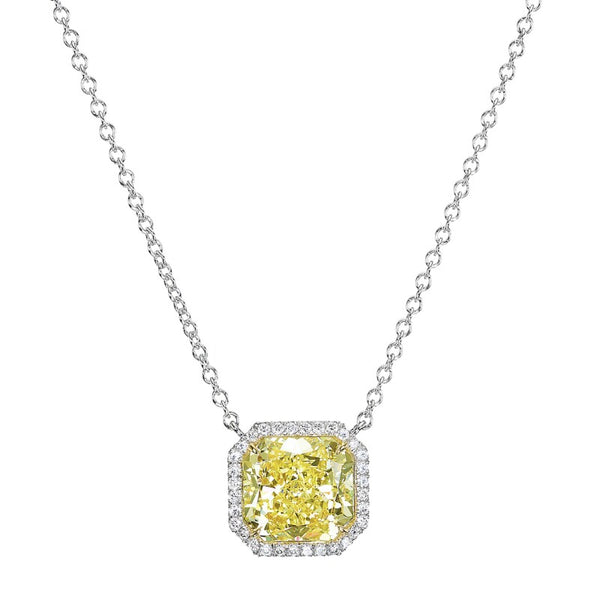
Image Source: Sothebys | Platinum, Gold, 5.01ct Fancy Yellow Diamond and Diamond Pendant Necklace
Buying Guide and Considerations
When buying 5 ct diamond jewellery, you want to ensure you are educated on the four c's. These are cut, clarity, colour and carat weight:
The Cut
A diamond's cut is not to be confused with shape; cut refers to how well a diamond's facets interact with light. The cut depends on the proportions, symmetry, and polish to ensure the greatest return of light possible in the diamond.
The cut has three important effects on the look of the diamond: brilliance, fire, and scintillation. Brilliance; the brightness created by the white light reflections, fire, the flashes of colour created by the dispersion of light, and scintillation, the sparkle of the diamond. It's important to ensure that a skilled cutter cuts your diamond as they balance optimal cut against maximum yield (carat weight) so you will have the best cut without sacrificing too much carat weight.
The Clarity
When diamonds are created naturally, they can have a variety of characteristics called inclusions and blemishes. The clarity of a diamond refers to the absence of these characteristics.
The number of inclusions or blemishes in your diamond will determine how flawless it is. If it has none, it is entirely flawless. This will affect the transparency and brilliance of the diamond depending on where it sits on the scale. However, unless the clarity sits towards the bottom of the scale (slightly included or included), it would be very hard to notice any inclusions or blemishes without a microscope.
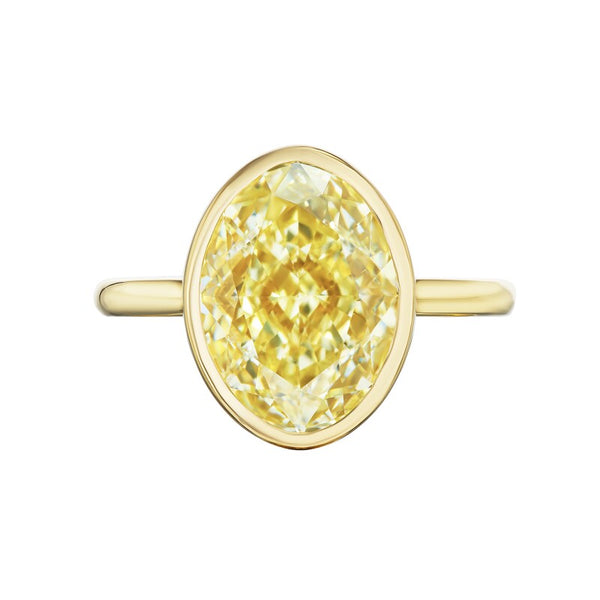
Image Source: Sothebys | Gold and 5.01ct Oval Bezel Set Diamond Engagement Ring
The Colour
The colour of a diamond makes quite a difference in the quality and, subsequently, price of the diamond. Evaluating the colour of the diamond is based on the lack of colour seen in the diamond. A pure and perfect white diamond has no colour or tone and is therefore highly valued.
A white diamond with a colour tint has a yellow hue, which lowers the diamond's value. The colour is graded on a scale comparing the degree of colourlessness (A scale from D - Z) under controlled lighting, which establishes the colour value. The lower the alphabet, the higher the yellow tint and the more cost-effective value.
The Carat
The carat weight of a diamond is equivalent to one-fifth of a gram, which means 1 carat is equal to 0.2 grams. Large-sized diamonds are so rare that the value of diamonds does not increase in proportion to their weight. This means that a two-carat diamond will cost more than double that of a one-carat diamond.

Image Source: Christies | Emerald-Cut Diamond of 5.01 Carats, Platinum
How to get the best value for your money?
There are several steps to ensure you find the best value for your money when diamond shopping. These include:
- Set your desired budget
- Find the highest quality within that budget
- The diamond price is determined by the four C's as described above.
When choosing a colour, select the closest to D (colourless/most expensive) your budget allows; this may be I or J. These colour grades are "near colourless", which to an untrained eye will appear very white.
When selecting a clarity, this might depend on the size. If the diamond is under 1 carat, SI is sufficient as this stands for "slightly included", and with that size diamond, you won't be able to see the inclusions.
However, for a diamond bigger than 1 carat, you will need VS "very slightly included" to ensure you don't see the inclusion.
Make sure the diamond you buy is certified with a GIA certificate to check all these details, including the cut grade. Ensure your diamond has a "good" cut grade to get the best value.
In summary, 5-carat diamonds represent a pinnacle of luxury and rarity in the world of high bespoke jewellery. Their substantial size and brilliance make them highly sought after by collectors and enthusiasts alike. Whether adorning bespoke engagement rings or bespoke high jewellery pieces, these diamonds command attention and hold significant value. As symbols of prestige and sophistication, 5-carat diamonds continue to captivate and maintain their status as coveted treasures in the industry.
